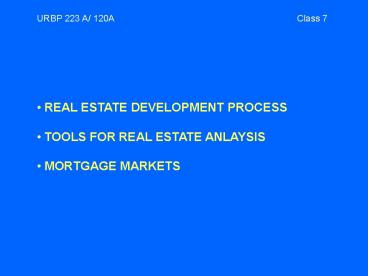REAL ESTATE DEVELOPMENT PROCESS - PowerPoint PPT Presentation
1 / 10
Title:
REAL ESTATE DEVELOPMENT PROCESS
Description:
REAL ESTATE DEVELOPMENT PROCESS. Basic Mantra: ... For owner of real estate return in 3 forms: Periodic cash flows from rents. Tax Consequences ... – PowerPoint PPT presentation
Number of Views:82
Avg rating:3.0/5.0
Title: REAL ESTATE DEVELOPMENT PROCESS
1
URBP 223 A/ 120A Class 7
- REAL ESTATE DEVELOPMENT PROCESS
- TOOLS FOR REAL ESTATE ANLAYSIS
- MORTGAGE MARKETS
2
- REAL ESTATE DEVELOPMENT PROCESS
- Basic MantraDevelop projects that are worth
more than they cost to develop - Value - Cost Profit
- For owner of real estate return in 3 forms
- Periodic cash flows from rents
- Tax Consequences
- Appreciation
3
- REAL ESTATE DEVELOPMENT PROCESS
- Project Feasibility- proformas, appraisals
- Land Control purchase, lease, options, joint
ventures - Project Design and Engineering- land
subdivision, infrastructure, buildings - Public zoning, subdivision regulations,
environmental review, building and occupancy
codes - Private Approvals private contracts
- Financing debt financing, equity investment
- Construction- scheduling, budget, quality
- Marketing- market analysis, marketing strategy,
lease terms - Project Operations (Property Management)
management and final disposition
4
REAL ESTATE DEVELOPMENT PROCESS People Involved
Adapted from George Rolfe. 2000. Real Estate
Development Process Course Reader. Seattle, WA.
5
- REAL ESTATE DEVELOPMENT PROCESS
- Project Feasibility- proformas, appraisals
- Proformas
- Static one point of time
- Income Proforma
- Cost Proforma
- Dynamic- over period of time
- Operating (I/E) Model calculate NOI, CF, and
Tax consequences - Sources/ Uses Model- cost and sources of capital
till T.O. Loan - Appraisals
- Cost method- replacement cost reproduction cost
- Comparable Sales Method- compare with recent
sales - Capitalized Income Method- value depending upon
NOI and CR (Cap Rate)
6
- REAL ESTATE DEVELOPMENT PROCESS
- Financing debt financing, equity investment
- Equity- cash, land, services
- Debt- cost minus equity. From lenders.
- Interim Loan till completion of the project
- and
- Take Out Loan- for longer duration (10-30 years)
- Mortgage Markets
- Primary mortgage market mortgage originators
are the lenders - Secondary mortgage market- mortgage originators
sell mortgage to investors
7
REAL ESTATE DEVELOPMENT PROCESS Mortgage
Markets
8
- REAL ESTATE DEVELOPMENT PROCESS
- Secondary Mortgage Markets
- Housing production local- financing global
- Spread the risk
- Increased efficiency
- Lower cost of credit
- Standardization mortgages underwriting
- More in single family then in multi-family
markets, because risk is difficult to assess.
9
REAL ESTATE DEVELOPMENT PROCESS Major
Institutional Payers in Secondary Mortgage
Markets Federal Housing Administration FHA
Created in 1934 to encourage homeownership
through 30 year loan term Promotes affordable
housing by providing mortgage insurance to high
loan to value loans (low down payment) Fannie
Mae Federal National Mortgage
Association Created in 1938 to purchase FHA
insured loans. 1948- began purchasing VA
mortgages 1970- began purchasing conventional
loans Earlier it used to hold the mortgage in
portfolio now sells it to investors.
10
REAL ESTATE DEVELOPMENT PROCESS Major
Institutional Payers in Secondary Mortgage
Markets Ginnie Mae- Government National Mortgage
Association Created in 1968 by splitting Fannie
Mae Ginnie Mae provides a secondary mortgage
market for FHA/VA loans and other mortgages to
support federal housing assistance
programs. Ginnie Maes MBS (mortgage backed
securities) are backed by Federal
Government. Freddie Mac Created in 1970 to
provide secondary mortgage markets for
conventional mortgages, especially mortgages
originated by thrifts (credit unions, mutual
savings, savings and loans, etc.) Freddie Mac
sells most of the mortgages to investors.
Promotes affordable housing by providing
mortgage insurance to high loan to value loans
(low down payment)































